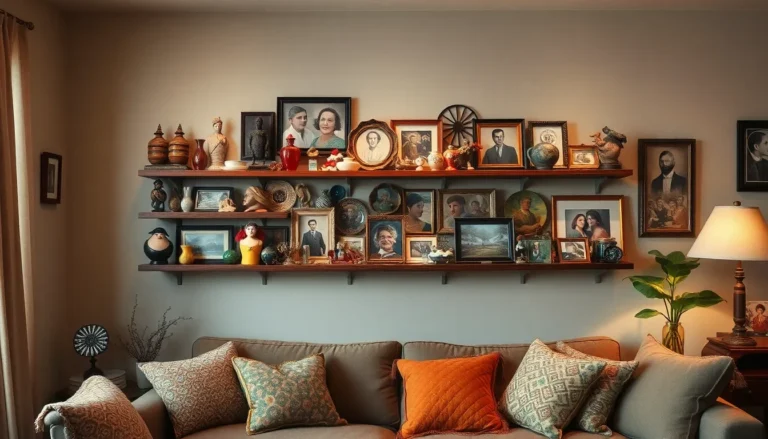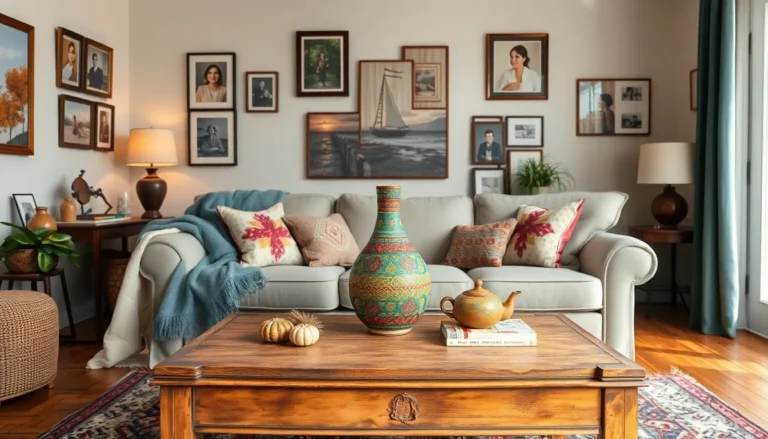In a world buzzing with deadlines and to-do lists, the charm of relaxed gathering spaces is like a warm hug on a chilly day. These cozy havens invite friends, family, and colleagues to kick back, unwind, and maybe even share a laugh or two over a cup of coffee. Imagine a place where stress melts away faster than ice cream on a summer day—sounds dreamy, right?
Table of Contents
ToggleUnderstanding Relaxed Gathering Spaces
Relaxed gathering spaces offer welcoming environments that cultivate connections among people. These areas invite individuals to step away from daily stresses and enjoy leisure time with others.
Definition and Characteristics
Relaxed gathering spaces are defined by their inviting nature and comfortable arrangements. They often feature cozy seating, warm lighting, and easy access to refreshments. Key characteristics include an informal atmosphere that encourages social interaction, flexibility in layout to accommodate various group sizes, and elements that promote a sense of community, such as art displays or local plants. Spaces like coffee shops, parks, and community centers exemplify these characteristics by providing inviting backdrops conducive to relaxed conversation.
Importance in Community Design
Community design increasingly recognizes the value of relaxed gathering spaces. Such spaces foster social ties by allowing people to connect and share experiences. Integrating these areas can lead to enhanced community wellbeing and cohesion. They promote inclusivity by serving as common ground, welcoming everyone regardless of background. In urban planning, creating more gathering spaces contributes to vibrant neighborhoods and encourages outdoor activities. Essentially, relaxed gathering spaces play a crucial role in strengthening community bonds and enhancing quality of life.
Types of Relaxed Gathering Spaces

Relaxed gathering spaces come in various forms, each offering unique experiences for social interaction and leisure. Understanding the distinctions among these spaces can enhance their appeal and usage.
Parks and Outdoor Areas
Parks and outdoor areas provide natural settings for relaxation and connection. They feature benches, picnic tables, and open green spaces. Families can enjoy picnics while friends engage in recreational activities. Nature often serves as a calming backdrop, fostering informal conversations. Community events frequently take place in these areas, promoting interaction among residents. Access to walking paths adds to their charm, encouraging leisurely strolls. Overall, parks serve as foundational elements in vibrant communities, enhancing social ties.
Cafés and Informal Meeting Spots
Cafés and informal meeting spots cater to those seeking casual atmospheres for gatherings. These spaces often include comfortable seating arrangements and friendly service. Patrons can enjoy a variety of beverages and snacks while engaging in relaxed conversations. Many cafés emphasize cozy décor, creating inviting environments for conversation or study. Wi-Fi accessibility allows for both social interaction and productivity. Additionally, hosting small events like book clubs adds to their communal focus. Overall, cafés act as crucial hubs for connecting individuals and fostering community bonds.
Benefits of Relaxed Gathering Spaces
Relaxed gathering spaces provide numerous benefits, enhancing both social interaction and individual well-being.
Social Connection and Community Engagement
Social connection thrives in relaxed gathering spaces. Friends, families, and colleagues frequently come together to share experiences. These environments promote effortless conversation through comfortable seating and welcoming atmospheres. Community engagement increases as people feel more inclined to participate in local events held in these spaces. Parks, cafés, and community centers serve as platforms for gatherings, encouraging collaboration and fostering friendships. Data shows that close-knit communities emerge when individuals gather regularly in such spaces. Increased interaction not only strengthens existing bonds but also fosters new relationships, creating a vibrant social network.
Mental Health and Well-being
Mental health benefits significantly from relaxed gathering spaces. Exposure to calming environments reduces stress, promoting relaxation and comfort. Serene settings, such as lush parks or cozy cafés, provide important breaks from daily routines. Regular visits to these gathering spots enhance emotional well-being by allowing individuals to unwind and recharge. Friendly interactions and informal conversations contribute to an uplifting atmosphere, essential for mental health. Studies indicate that positive social interactions in inviting environments decrease feelings of loneliness and isolation. Prioritizing tranquility and connection in everyday life leads to improved overall well-being.
Designing Effective Relaxed Gathering Spaces
Creating effective relaxed gathering spaces involves thoughtful design that promotes comfort and encourages social interaction. Key elements enhance these settings and boost their inviting nature.
Key Elements to Consider
Seating arrangements play a vital role in fostering conversation. Comfortable sofas, armchairs, and communal tables facilitate easy interaction. Lighting options, such as soft lamps or warm overhead fixtures, create a cozy atmosphere. Accessibility features ensure everyone can enjoy the space. Incorporating various zones—like quiet nooks and group settings—accommodates diverse social preferences. Refreshment stations, positioned conveniently, support lingering and lounging. Each element contributes to an overall sense of warmth and welcome, making the space ideal for gatherings.
Incorporating Nature and Greenery
Integrating nature into relaxed gathering spaces promotes emotional well-being. Plants enhance air quality and add aesthetic value, creating a more inviting environment. Natural light, when utilized effectively, boosts mood and encourages people to stay longer. Providing views of gardens or outdoor areas connects individuals to their surroundings. Outdoor seating encourages fresh air and interaction with nature. Seasonal flowers or greenery can bring vibrancy and life throughout the year. Each of these aspects fosters tranquility and helps reduce stress in social settings.
Relaxed gathering spaces are essential for nurturing connections and enhancing community well-being. These inviting environments provide a much-needed refuge from daily stressors, allowing individuals to unwind and engage in meaningful conversations. By fostering social interaction and creating a sense of belonging, they contribute significantly to the vibrancy of neighborhoods.
The thoughtful design of these spaces, with comfortable seating and natural elements, encourages people to linger and connect. As communities continue to prioritize relaxed gathering spaces, they pave the way for stronger social ties and improved mental health. Embracing these welcoming havens can transform everyday interactions into cherished moments, enriching lives and enhancing community dynamics.



